
Inclusion. Equity. Community Engagement. These are all terms that float around the transportation world, but how do you turn these words into effective and intentional action?
Veronica O. Davis, author of Inclusive Transportation: A Manifesto for Repairing Divided Communities, invites the reader to challenge their existing transportation planning ideas and envision a new era of centering people in all processes.
The Legacy of Transportation
In chapter one, Veronica asks the reader to reflect on their transportation story. Veronica is Director of Transportation & Drainage Operations for Houston, Texas, leading the team responsible for maintaining and improving the infrastructure that spans Houston’s 671 square miles. Veronica has nearly 20 years of experience in engineering and transportation planning. She is an Entrepreneur and Civil Engineer, co-founding Nspiregreen, LLC., which manages Community, Multimodal Transportation, and Environmental planning and consulting. She co-founded Black Women Bike, an organization and movement that builds a community and interest in biking among black women through education, advocacy, and recreation. Veronica was recognized as a Champion of Change by the White House in 2012 for her professional accomplishments and advocacy.
Her story is a legacy of family ties to the transportation world. Her father had a 31-year career as a civil engineer and planner. Her grandparents on her dad’s side owned the Lincoln Cab Company in Raleigh, North Carolina which originated to provide rides to Black riders who otherwise could not access taxis and also transportation for school children. Her mother worked in human resources for the New York City Transit Authority (NYCTA) for 21 years and almost gave birth to Veronica at the Urban Mass Transportation Administration where her father worked at the time! She is also no stranger to the devastation that transportation decisions can have on communities. In the 1960s, her mother’s family home and high school in Baton Rouge were destroyed to make way for Interstate 10. This was not an uncommon story for many Black communities at that time and the impact of highway development is still felt today.
She reminds us that the pain of unjust transportation practices is still very present for those affected. “I share this story as a reminder to all of us in this work, whether we are an advocate, engineer, or decision maker, that people are alive today that remember what these communities were before the highway showed up,” Veronica states that the hostility that may be felt by residents of these communities isn’t always about today’s project, but it is a pain resurfacing from decades ago that was never acknowledged.
Watch Our Full Webinar With Veronica Here:
“Self-Awareness is Your Most Important Tool”
Veronica reminds us in her book that American history is not ancient history. One of her favorite lines is “Self-awareness is your most important tool.” That’s why understanding our own transportation story and the why behind our preferred modes of transportation is so important. We can use our experiences to relate to the communities we are serving. Although she has more awareness of these issues than most from her upbringing, she was not immune to tough conversations and eye-opening community engagement experiences.
She recalls how mentors throughout her career showed her that engineering is about more than just design and that people should be at the center. Likewise, she shares that a strategy for capacity building is key to community engagement. “Capacity building moves beyond engagement to ask how you are providing resources for the community to continue to expand its work.” Veronica shares that planners and engineers are not trained in how to interact with communities which leads to a disconnect and activities that simply check the boxes. One of the reasons she wrote this book was to be a resource for those going through planning and engineering programs. “They have to get their speech from technical to the living room.”
Equity is About Prioritization
Veronica lays out equity as a foundation of her book but intentionally does not define it for readers. “I don’t really define equity because it really is going to be different depending on what your problem is, what your community is, and what’s going on.” She doesn’t want professionals to get so attached to an exact definition that they lose sight of the many facets of equity. Veronica explains with equality everyone gets the same and with equity, everyone gets what they need. The challenge with equity and giving everyone what they need is that this is often unattainable, especially financially.
This is why she elevates prioritization as the solution. In the book, she uses the analogy of an Emergency Room triage system, “some communities require immediate attention and resources in order to be stabilized.” These communities may require ongoing attention (similar to being admitted to a hospital). She acknowledges that this framework is hard and is not meant to ignore the needs of other communities, but addresses the critical condition of communities with high injury networks where people are dying. “To get to this point of equity, you have to have political will and you have to have bold leadership to be able to say, ‘We said this is important, and we will circle back to you.”
From Chapter 6 – The Task Ahead: Where the Hard Work Continues:

Lead With Action
Inclusive Transportation does just encourage the reader to reflect but to take the lessons learned and put them into action. For many communities, time is not on their side, and implementing the practices in this book (community engagement, equity frameworks, empathy, data collection, etc.) is crucial to saving lives.
“The transportation sector needs to put more emphasis on working with communities on short-term solutions that help them stabilize while we also work with them to develop a longer-term solution.”